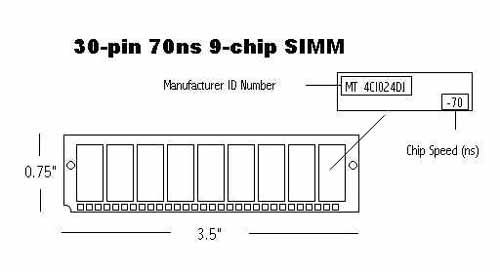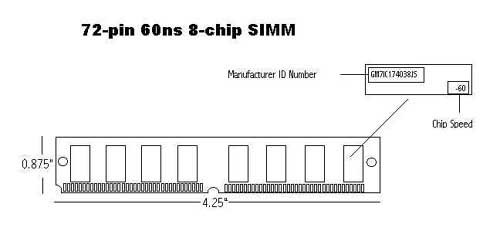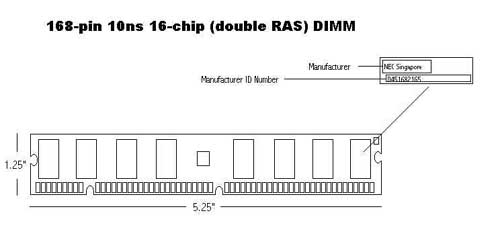Ouch...look at all of those pins!
Back in the early days of the Intel 386 processor a number of firsts were made, Intel released their first 32 bit processor (yes the 386 was a 32bit processor) and motherboard manufacturers started experimenting with different types of memory technology...the result? The Single In-Line Memory Module, or SIMM for short. Since SIMMs became popular a variety of styles, sizes and speeds have been released. The most popular with the 386 was the classic 30-pin SIMM, at first only available in a 8/9chip version (the 9 chip version being a Parity version) and later in a 2/3 chip version (the 3 chip version being a Parity version). Below you can see the physical differences between a 9 and a 3 chip 30-pin SIMM, as well as the markings on the individual chips.


Although they lasted until late in the 486 days, the 30-pin SIMMs quickly became obsolete, mainly due to their 16 bit bandwidth. With the Pentium and its advanced 64 bit bus on the way, and the 32 bit 486 taking control of the market a new solution was necessary, therefore the 72 pin SIMM was created. Boasting twice the bandwidth of a 32 pin SIMM, the 72 pin SIMM could be easily used in single modules with any 32 bit processor/bus. Also with the 72 pin SIMM emerged Extended Data Out or EDO SIMMs which became quite popular with the Pentium and Pentium Pro class machines (and now Pentium II systems).

As you can tell a 72 pin SIMM is about 0.75" longer than a standard 30 pin SIMM, and like a 30 pin SIMM can only be installed one way (courtesy of the tiny notch at the left side of the SIMM). However, with Pentium and Pentium Pro/II systems, due to their 64 bit wide bus, the 32 bit wide 72 pin SIMMs must be installed in pairs, therefore somewhat limiting memory expansion. The market's solution? The Dual In-Line Memory Module, or DIMM. The DIMM is, as the name implies, basically a double sided SIMM. Not double sided in that both sides of the DIMM have chips on them, but double sided in that there are pin contacts on both sides of the connector. Much like SIMMs, DIMMs can be found in a variety of sizes, the most common being 72 pin DIMMs (36 pins per side, very small, used in laptops), 144 pin DIMMs (72 pins per side), and the now standard 168 pin DIMMs (84 pins per side, used in desktop systems). Below you can see an illustration of a 168-pin SDRAM DIMM.

The 168 pin DIMM is a full inch longer than a 72 pin SIMM, and unlike most normal SIMMs isn't meant to be installed at a 45 degree angle. You simply push it into the DIMM Socket at a 90 degree angle and snap the two opposite levers into the notches on the DIMM (shown at the left and right of the module by a semi-circle). As I mentioned before, DIMMs are found only in Pentium and Pentium Pro/II class systems and do not need to be installed in pairs to function properly since they have a 64 bit wide data path which is perfectly paired with the 64 bit bus of the Pentium and Pentium Pro/II systems today. It is very obvious that DIMMs are the future, it will just be a little while until they become more mainstream.
When dealing with the "packaging" RAM comes in, you also must consider single and double sided modules, sometimes referred to as single and double RAS SIMMs/DIMMs. Here is a small chart which illustrates chip sizes, and memory configurations:
| Type | Pins | Chips | Double Sided | Total Module Size |
| 1 x 32 SIMM | 72 | 8 | 4MB | |
| 2 x 32 SIMM | 72 | 16 | * | 8MB |
| 4 x 32 SIMM | 72 | 8 | 16MB | |
| 8 x 32 SIMM | 72 | 16 | * | 32MB |
| 16 x 32 SIMM | 72 | 8 | 64MB | |
| 32 x 32 SIMM | 72 | 16 | * | 128MB |
| 1 x 64 DIMM | 168 | 8 | 8MB | |
| 2 x 64 DIMM | 168 | 8 | 16MB | |
| 4 x 64 DIMM | 168 | 8 | 32MB | |
| 4 x 64 DIMM | 168 | 16 | * | 32MB |
| 8 x 64 DIMM | 168 | 16 | * | 64MB |
| 16 x 64 DIMM | 168 | 16 | * | 128MB |
How do you calculate memory sizes? Lets take a 4MB 32 bit 72 pin SIMM for example, 1 x 32, or 1MB x 32 bits. If you divide the 32 bits by 8 you get a total of 4 bytes (8 bits in a byte, see Bits, Bytes, and Transfer Rates). Therefore 1MB x 4 = 4MB. The same applies for 64 bit DIMMS, you take a 8MB 64 bit 168 pin DIMM, 1 x 64, or 1MB x 64 bits. And if you divide the 64 bits by 8 you get a total of 8 bytes (8 bits in a byte, see Bits, Bytes, and Transfer Rates), therefore 1MB x 8 = 8MB or an 8MB DIMM. When dealing with SIMMs you usually want to avoid modules with over 24 chips, as most motherboards haven't been tested with them and you may experience system instability as a result. Be sure to ask your salesman how many chips will be on your modules before ordering!










0 Comments
View All Comments